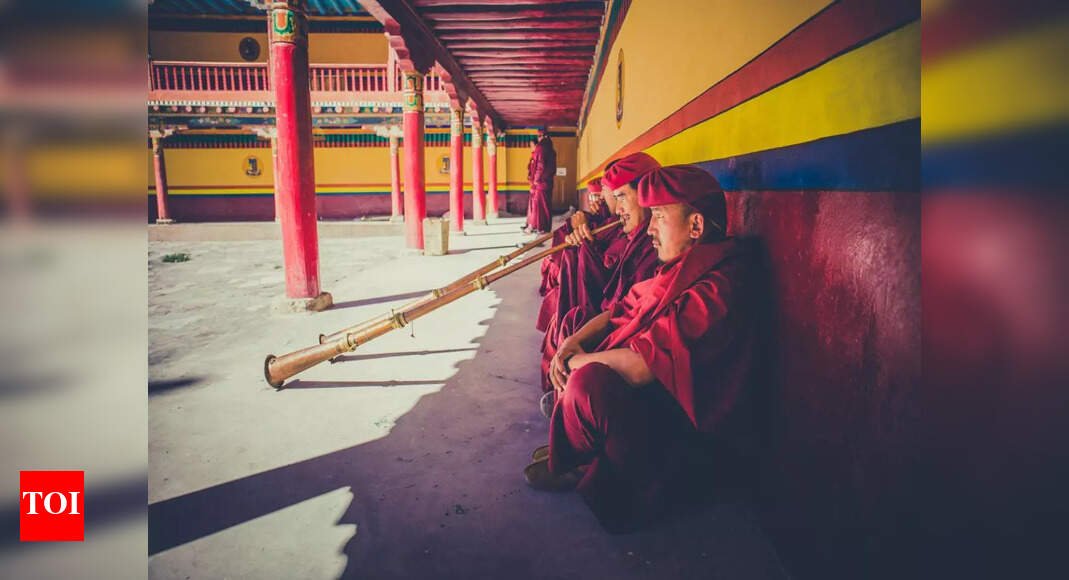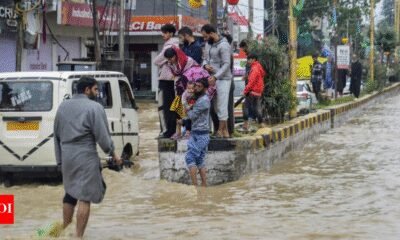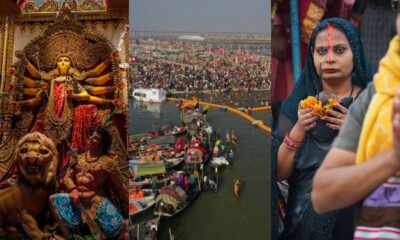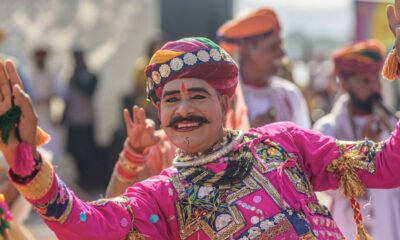Travel Guides & Articles
Delhi, India Emerges As The Unrivaled Destination In Agoda 2025 Repeat Visitor Rankings Featuring Its Captivating Landmarks And Timeless Heritage

Published on
August 13, 2025
Delhi, India has claimed the top spot in Agoda’s 2025 Repeat Visitor Rankings, earning its status as an unrivaled destination due to its rich blend of timeless heritage, iconic landmarks, and vibrant cultural experiences. Travelers return repeatedly to explore the city’s historic monuments, bustling markets, and serene retreats, making it a favorite for those seeking both cultural depth and immersive experiences.
Agoda’s recent analysis highlights Delhi as the leading city in the Repeat Visitor Ranking 2025, underlining its increasing appeal among travelers. The study, covering the first half of 2025, indicates that several Indian cities are seeing a surge in return visits, with travelers making multiple trips to the same locations within months. This trend reflects growing loyalty and a desire for immersive experiences. Delhi and the National Capital Region (NCR) top the rankings, followed closely by Chennai, Mumbai, and Bengaluru. Notably, Kochi has also emerged as a repeat-visit favorite, winning over travelers with its unique charm and cultural allure.
Why These Cities Attract Repeat Visitors
Delhi captivates visitors with a combination of history, culture, and modern urban life. Travelers visit its iconic landmarks, including the Red Fort, India Gate, Humayun’s Tomb, and Qutub Minar, and enjoy the city’s vibrant streets, markets, and culinary delights. Its central location allows travelers to explore nearby destinations such as Agra, home to the Taj Mahal, or hill stations like Shimla and Mussoorie, making Delhi a convenient base for varied travel experiences.
Chennai, Mumbai, and Bengaluru continue to draw repeat visitors thanks to their seamless connectivity and wide-ranging attractions. Serving as gateways to vibrant cultural districts, scenic coastlines, and key commercial hubs, these cities offer a mix of bustling urban life and relaxing leisure activities. The combination of dynamic city experiences and abundant entertainment options motivates travelers to return time and again.
Kochi: A Cultural Gem in Kerala
Kochi emerges as a unique repeat-visit favorite. The city serves as a gateway to Kerala’s famous backwaters, yet it has developed a strong identity of its own. Visitors return to Kochi to explore its historical sites, rich culture, and relaxed pace of life, which contrasts sharply with the busy metros.
The city showcases a colonial legacy through its architecture, with influences from the Portuguese, Dutch, and British eras visible in its streets and buildings. Kochi also narrates India’s maritime history, attracting travelers interested in both culture and heritage. Annual cultural events, particularly the internationally renowned Kochi-Muziris Biennale, draw art lovers repeatedly, reinforcing the city’s position as a top destination for return visits.
A Growing Trend in Travel Behavior
Agoda’s research reveals a clear change in traveler behavior, with a growing number of visitors revisiting the same city within a six-month period, highlighting stronger loyalty to destinations. Modern travelers now value deep cultural experiences, authentic engagement, and immersive exploration more than simply seeking something new.
This trend extends beyond India. Cities such as Bangkok, Tokyo, Seoul, Bali, and Osaka also top the global repeat visitor charts. These rankings highlight a broader change in tourism: travelers now value destinations that offer rich experiences and personal connections, returning multiple times to enjoy what they missed or to deepen their understanding.
Key Attractions Driving Delhi’s Popularity
Several landmarks make Delhi a favorite for repeat visits:
- Red Fort: This 17th-century Mughal fort, built with red sandstone, hosts palaces, halls, and gardens. Visitors enjoy evening sound-and-light shows and cultural events that bring history to life.
India Gate: This iconic memorial pays tribute to the soldiers who lost their lives in World War I. Surrounded by expansive lawns and open grounds, it remains a favorite destination for evening strolls and relaxed outdoor gatherings.
Qutub Minar: Standing 73 meters tall, this magnificent brick minaret holds the title of the world’s tallest and is recognized as a UNESCO World Heritage Site. Visitors are captivated by its detailed craftsmanship and rich historical legacy.
Lotus Temple: Shaped like a blossoming lotus, this Bahá’í House of Worship invites individuals from every faith. Guests are drawn to its tranquil atmosphere and calming surroundings, offering a serene retreat from the city’s hustle.
- Chandni Chowk: One of Delhi’s oldest markets, Chandni Chowk attracts shoppers with its narrow lanes, traditional goods, spices, textiles, and street food. The bustling market offers a quintessential Delhi experience.
Why Travelers Return to Indian Cities
Delhi, Chennai, Mumbai, Bengaluru, and Kochi share one common trait: they offer varied and meaningful experiences. Travelers return to these cities because they combine accessibility, history, culture, entertainment, and culinary exploration. Kochi’s rise in popularity shows that smaller, culturally rich cities can also compete with large metropolitan hubs.
Repeat visits reflect travelers’ desire to engage with a city more deeply, whether by exploring lesser-known attractions, participating in cultural events, or revisiting familiar sites with fresh perspectives. This evolving pattern of travel indicates that loyalty is becoming a defining factor in tourism, as travelers increasingly prefer experiences that allow them to return and rediscover destinations.
Delhi, India tops Agoda’s 2025 Repeat Visitor Rankings, earning its unrivaled status as travelers return for its captivating landmarks, rich heritage, and immersive cultural experiences.
The Repeat Visitor Ranking 2025 by Agoda highlights a major trend in tourism: travelers now favor cities that provide rich, immersive experiences over novelty alone. Delhi’s top position underscores its enduring appeal, while Chennai, Mumbai, Bengaluru, and Kochi demonstrate the breadth of India’s attractions. Kochi’s emergence as a repeat-visit favorite emphasizes the growing interest in cultural and heritage-focused destinations.
Indian cities are no longer just one-time stops; they are becoming destinations that travelers choose to return to repeatedly, valuing deep engagement, cultural richness, and meaningful experiences. This trend signals a new era in tourism where cities earn loyalty not just through attractions, but by offering immersive and unforgettable experiences that invite visitors back, time and again.
Travel Guides & Articles
India’s Cultural Wanderlust on the Rise: Skyscanner Reveals 8 in 10 Indians Plan Trips Around Culture in 2025

India, 4th September 2025: Leading global travel app Skyscanner recently released its latest Cultural Tourism report, highlighting a rising trend among Indians travelling in pursuit of authentic local heritage, traditions, and experiences. According to the findings, 82% of Indian travellers are very keen on visiting destinations primarily for their cultural offerings, with younger generations – Millennials (84%) and Gen Z (80%) leading this rising wave of cultural curiosity. This enthusiasm is evolving into a quest for depth as many travellers define cultural tourism not by the sights they see but by the knowledge they gain, with 39% considering a trip successful when they return home having learnt something new about the place or its people.
The report also reveals a striking shift: 76% of Indian travellers have altered their travel plans to attend a cultural event, underlining how traditions and festivals are no longer side activities but central to holiday decisions. This cultural curiosity isn’t limited by geography. 7 in 10 travellers say they are open to exploring cultural experiences domestically and internationally. At its core, Indians are seeking authentic, immersive adventures that allow them to participate, learn, and return home with stories that truly feel transformative.
Festivals as the Biggest Magnets for Cultural Travel
Indian festivals are emerging as some of the biggest draws for travellers. As per the report:
- Over half of Indian travellers (55%) have attended local festivals, fairs, or cultural events.
- Durga Puja in Kolkata (53%), Lathmar Holi in Barsana (51%), and Onam in Kerala (35%) lead the list of occasions travellers are most eager to witness live this year.
- Beyond festivals, 53% of travellers are drawn to historical cities like Jaipur and Varanasi, while 39% are inspired to explore UNESCO World Heritage Sites such as Taj Mahal in Agra and Hampi in Karnataka. In fact, Skyscanner data shows searches to Varanasi, one of India’s most storied cultural cities, has risen by 76% for travel in 2025 compared to the previous year!
- Celebrated for their festive traditions, architectural grandeur, and local heritage, Kerala (32%) and Rajasthan (30%) have also emerged as India’s culture capitals.
Growing Interest in Underrated Destinations
Beyond these, travellers are curious to explore places that preserve traditions away from the crowds. A remarkable 93% are eager to seek out lesser-known destinations offering authentic cultural experiences, signalling a strong appetite for hidden gems where authentic traditions thrive away from crowded tourist trails. One way to explore these hidden treasures is by using ‘Explore Everywhere’ search feature on Skyscanner, with filter options like ‘underrated destinations’ and ‘art and culture’ to make it easier than ever to find the perfect spot for a unique tradition-rich escape.
“Indian travellers are moving beyond holidays taken only for leisure. The growing quest for depth has given rise to a new archetype – the culture curious traveller – one who seeks knowledge, connection and fulfilment,” said Neel Ghose, Skyscanner Travel Trends and Destinations Expert. “For them, success is measured in stories carried home that deepen their sense of people and place. Interestingly, our report also highlights that 71% prefer to travel with family, followed by 62% with friends, and 56% with a partner or spouse. This shows travel today is shifting from sights seen, to connections deepened — and Skyscanner’s all-in-one app makes it easier and more affordable to plan those meaningful journeys.”
From Observing to Immersing
As this cultural wave builds, a few patterns are emerging, showcasing how Indians plan, and experience escapes rooted in tradition. The report shows that nearly 4 in 10 want to explore heritage villages or eco-cultural communities, while 38% are drawn to culinary trails revealing the historic roots of local cuisines. Reflecting on this trend towards hands-on, participatory experiences, Dr. Aditi Rawat, Associate Fellow, Pahle India Foundation, policy think tank advancing research-led ideas on India’s economic development and governance, said, “Cultural tourism is fast becoming a defining lens through which Indian travellers experience their country and the world. The trend is moving towards combining cultural discovery with comfort, luxury, and leisure – a blend that encourages longer stays and deeper engagement. Catalysed by rising accessibility, robust infrastructure, and digital connectivity, it is reshaping travel from passive sightseeing to immersive storytelling, where visitors engage with living heritage, local traditions, and cultural narratives that define each destination.”
Safety and Smart Planning Drive Choices
In their sojourns, practical considerations remain front and centre amongst Indian travellers. When choosing a cultural trip:
- Safety (45%) tops the list of considerations when choosing a cultural trip, followed by authenticity (33%) and seasonality (31%).
- 41% travellers start preparing one to two months ahead. Their inspiration is shaped by a mix of influences: 45% turn to social media, 39% rely on friends and family, and 27% use apps like Skyscanner to discover the right destinations and deals.
- When it comes to finalising plans, value remains top of mind, with 60% saying the best time to book festival flights is their most helpful planning insight, while 58% depend on fare comparisons to make smarter choices.
To further assist Indians in charting their journeys, Neel Ghose added, “For travellers seeking inspiration, describing your ideal getaway on Skyscanner’s app-only AI feature, Savvy Search can help uncover temple cities, native lands, royal palaces, and more. The tool curates a list of destinations based on the prompts, directing you to Skyscanner’s flight search, letting you compare the best prices. And, when it comes to planning, for those looking to make the most of their holiday around a festival, a simple hack is to use the ‘Whole Month’ view to spot the cheapest days to fly around the date! Smart planning choices like these can help unlock cultural experiences without breaking the bank, letting you create memories and returning home with learnings that last a lifetime.”
A Broader Shift in Tourism
This growing interest is an indicator that culture-led exploration will also steer the future of the country’s tourism industry. Sharing insights on this rising phenomenon and its implications, Dr. Aditi Rawat, said, “This shift is being fulfilled by traditional towns and authentic locale-based experiences that connect travellers with communities and their way of life. Think the Northeast India, with its extraordinary cultural diversity and pristine landscapes, or Kerala, with its backwaters, classical art forms, and Ayurvedic traditions, both now firmly on the radar of discerning tourists. From tribal festivals in Arunachal Pradesh to tea and wellness in Assam, or narrative Kathakali performances in Thrissur, we are witnessing curated experiences true to each destination’s strengths. Coupled with leisure travel and government initiatives such as Dekho Apna Desh, Swadesh Darshan 2.0, and Adopt A Heritage, this cultural discovery is transforming tourism into a powerful custodian of India’s identity. It is revitalising economies, positioning diversity as a global asset, and turning sites and practices into hubs that attract global visitors, empower local communities, and shape the future of India’s tourism economy.”
Post Views: 6
Travel Guides & Articles
Thomas Cook India & SOTC Travel introduce special festival tours during Durga Puja, Dussehra and Diwali season

- Strong travel intent to travel during the festive period with family/ extended families and adhoc group of friends
- Festive tours include special regional group departures from high-potential source markets like West Bengal, Karnataka, Gujarat and Maharashtra. Tours accompanied by an experienced regional tour manager
Mumbai, September 4, 2025: Traditionally, Indian festivals have been celebrated at home or in ancestral houses, with families gathering under one roof. However, a strong trend being witnessed is that Indian consumers are increasingly choosing to travel and celebrate festivals – together as multi-generational family units and friends. Thomas Cook India and SOTC Travel’s India Holiday Report 2025 reiterates this changing consumer behaviour, reflecting demand for longer festive breaks, higher holiday spends and a growing appetite for new experiences—from heritage and luxury stays to cruises and unexplored destinations.
To tap into this growing festival travel trend, Thomas Cook (India) Limited – India’s leading omnichannel travel services company – and its Group Company, SOTC Travel, have introduced a specially curated range of holidays for the upcoming festive season, featuring special group tour departures from Kolkata for Durga Puja and Karnataka for Dussehra, as well as from high-potential markets of Gujarat and Maharashtra. In addition, the companies have also announced special Diwali departures across key pan-India markets.
In addition, the Companies have announced a special offer: Discounts of up to Rs.10000 per transaction across select holidays via HDFC credit cards.
Festive tourism trends
· Longer stays and increased spends: From the traditional 3 days Indians are now extending their stays to 6-12 days (multi-generational families combining school vacations like Dussehra, Durga Puja and Diwali). Young India’s millennials/GenZ and working professionals are embracing extended trips, combining weekends with festival holidays for a 5-6 day break
· Favourite destinations:
o Domestic & Indian Subcontinent: Andaman, Kerala, Kashmir, Himachal Pradesh, Rajasthan, Goa, Karnataka, North East, Sri Lanka, Bhutan and Nepal
o International: Thailand, Singapore with Bintan, Malaysia, Sabah, Indonesia, Vietnam, Oman, Australia-New Zealand, Switzerland, France, Finland, Japan, Georgia, Germany, Spain, Austria, Kenya, South Africa, Dubai, Abu Dhabi, Maldives, Mauritius, South Korea
o Visa-Free, Visa-on-arrival and easy-visa destinations in demand: Thailand, Malaysia, Philippines, Sri Lanka, Nepal, Bhutan; Dubai-Abu Dhabi, Indonesia, Maldives
· Spiritual Journeys: Leveraging festive sentiment, Thomas Cook and SOTC have curated spiritual journeys through their Spiritual Journeys & Darshans portfolio – featuring Char Dham, Kashi, Ayodhya, Rameswaram, Tirupati, Amritsar, Varanasi, Prayagraj, Dwarka and Sri Lanka with special themed tours such as ‘Ramayan Anant Yatra’ and ‘Ramayan Trails’
· Premium/affordable luxury travel: Customers are opting for luxury resorts and spas, with destinations like France, Switzerland, Scandinavia, South Korea, Japan, Singapore, Australia, New Zealand, Oman, Morocco, Seychelles
· Cruising: Strong interest for sailings across South East Asia and the Middle East (Costa Cruises, Resorts World Cruises); premium sailings like Disney Cruise Line in Australia and Singapore; domestic (Cordelia)
· Festival regional group tours: The Companies are witnessing strong interest in their regional tours: Adhbhut Asia, Alokik Asia, Ashadharon Vietnam, Duronto Dubai O Abu Dhabi, Akorshonio France O Swiss with departures accompanied by regional tour managers; on-tour puja and curated vegetarian meals on select tours
Mr. Rajeev Kale, President & Country Head, Holidays, MICE, Visa – Thomas Cook (India) Limited said, “Travel has become non-negotiable and festive tourism serves as a powerful cultural driver. We are witnessing a strong and exciting trend—Indians are no longer staying at home but increasingly choosing to celebrate festivals while travelling. This is reiterated in our India Holiday Report 2025 that also reveals a strong shift—85% of Indians are increasing their travel frequency and budgets, driven by a desire to celebrate culture in immersive, meaningful ways.
Hence, to maximise this opportunity we have launched innovative festive regional groups tours like Adhbhut Asia, Alokik Asia, Ashadharon Vietnam, combining local and authentic experiences to meet the aspirations of India’s new-age travellers.”
Mr. S.D. Nandakumar, President & Country Head – Holidays and Corporate Tours, SOTC Travel Limited said, “India’s festive calendar is fast emerging as a powerful travel driver. Families and friends and are increasingly using these breaks to create multiple holidays rather than a single long annual holiday. Significantly, this trend is not restricted to customers from metro cities, but also from India’s tier 2 and 3 markets, reflecting a strong, nationwide aspiration to travel. Travellers are also embracing new formats—cruise holidays, boutique and heritage stays, luxury villas and immersive experiences like culinary trails and adventure activities.. At SOTC, we have designed our festive portfolio to blend celebration with exploration—curating domestic and international tours that allow Indians to experience their festivals in unique settings, while creating deeper connections and lasting memories.”
Travel Guides & Articles
India travel update: Citizens of these neighbouring countries no longer require to carry passport or visa to enter India |

In a bid to promote cross-border tourism, the Indian Ministry of Home Affairs (MHA) has announced that citizens of Nepal and Bhutan can enter India without a passport or visa starting September 1, 2025. The Immigration and Foreigners (Exemption) Order, 2025, allows citizens of Nepal and Bhutan to enter India when arriving by land or air through their respective borders (without a passport or visa). The MHA informed, the requirement of a passport or any other travel documents, a visa for entry into, stay in and exit from India shall not apply if “a citizen of India entering into India by land or by air over the Nepalese or Bhutanese frontier, a citizen of Nepal or Bhutan entering into India by land or air over the Nepal or Bhutan border or if he possesses a valid passport while entering or exiting India from or to a place other than Nepal or Bhutan but not from China, Macau, Hong Kong or Pakistan”.As per the MHA’s notification under Section 33 of the Immigration and Foreigners Act, 2025:Citizens of Nepal and Bhutan coming by land or air from their respective countries are not required to show a passport or visa.The rule is also applicable to Indian nationals entering India by land or air via Nepal or Bhutan.However, citizens of Nepal and Bhutan must carry valid passports and visas if entering from any third nation—except if arriving with such documents from China, Macau, Hong Kong, or Pakistan.Identity Documentation
Nepali and Bhutanese citizens still need to carry valid identity proof such as:Citizenship certificateVoter ID (issued by the Election Commission of their country)Limited-validity photo-ID issued by their mission in IndiaFor kids aged 10–18, a school principal’s photo-ID accompanying parents; no ID required for children under 10Extended Exemptions under the New Order
The 2025 exemption consolidates and replaces earlier provisions (1957 and 2007 orders), and also extends passport and visa relaxations to:Members of Indian Armed Forces, along with their families when travelling on government transport Registered Tibetans who entered via Special Entry Permits issued by the Indian Embassy in Kathmandu, both before and after May 30, 2003 Minority community refugees (Hindus, Sikhs, Buddhists, Jains, Parsis, Christians) from Afghanistan, Pakistan, and Bangladesh who entered India on or before December 31, 2024, regardless of whether their travel documents are valid or expired Registered Sri Lankan Tamils who took shelter in India on or before January 9, 2015Impact on travellersNow Nepali and Bhutanese tourists and travellers planning to explore India can do that without worrying about a passport or visa. For tourism or personal visits, citizens from Nepal and Bhutan can directly enter from their home country using alternate IDs. This will simplify the documentation process and boost cross-border connectivity, trade, and ties while preserving national security.
-

 Business6 days ago
Business6 days agoThe Guardian view on Trump and the Fed: independence is no substitute for accountability | Editorial
-
Tools & Platforms3 weeks ago
Building Trust in Military AI Starts with Opening the Black Box – War on the Rocks
-

 Ethics & Policy1 month ago
Ethics & Policy1 month agoSDAIA Supports Saudi Arabia’s Leadership in Shaping Global AI Ethics, Policy, and Research – وكالة الأنباء السعودية
-

 Events & Conferences4 months ago
Events & Conferences4 months agoJourney to 1000 models: Scaling Instagram’s recommendation system
-

 Jobs & Careers2 months ago
Jobs & Careers2 months agoMumbai-based Perplexity Alternative Has 60k+ Users Without Funding
-

 Education2 months ago
Education2 months agoVEX Robotics launches AI-powered classroom robotics system
-

 Funding & Business2 months ago
Funding & Business2 months agoKayak and Expedia race to build AI travel agents that turn social posts into itineraries
-

 Podcasts & Talks2 months ago
Podcasts & Talks2 months agoHappy 4th of July! 🎆 Made with Veo 3 in Gemini
-

 Podcasts & Talks2 months ago
Podcasts & Talks2 months agoOpenAI 🤝 @teamganassi
-

 Education2 months ago
Education2 months agoAERDF highlights the latest PreK-12 discoveries and inventions





















